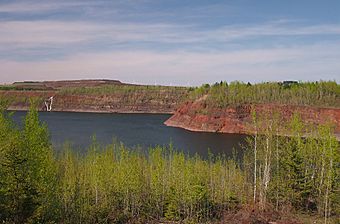Mountain Iron Mine facts for kids
|
Mountain Iron Mine
|
|

Mountain Iron Mine from a city overlook
|
|
| Location | North of Mountain Iron, Minnesota |
|---|---|
| Area | 240 acres (97 ha) |
| Built | 1892 |
| NRHP reference No. | 68000052 |
Quick facts for kids Significant dates |
|
| Added to NRHP | November 24, 1968 |
| Designated NHL | October 10, 1968 |
The Mountain Iron Mine is a former mine located in Mountain Iron, Minnesota. It opened in 1892. This mine was the very first one on the Mesabi Range. The Mesabi Range is the largest iron ore deposit ever found.
Mining at this site stopped in 1956. The bottom of the open-pit mine is now filled with water. However, you can still clearly see how big it is. The city has a special viewing spot at Mountain Iron Locomotive Park.
The Mountain Iron Mine became a National Historic Landmark in 1968. This means it is a place of great importance to the history of the United States. It was also added to the National Register of Historic Places. This was because of its huge impact on American industry. The mine helped start the mining of iron ore on the Mesabi Range. This made Minnesota the biggest iron producer in the nation. It also helped the United States become the world's top steel maker.
History of the Mountain Iron Mine
In 1887, a man named Leonidas Merritt found a large rock of high-quality iron ore. He found it while surveying for a railroad. This discovery led him and his brothers to open the Mountain Iron Mine in 1892.
By 1893, the "Seven Iron Brothers" owned many claims on the Mesabi Range. They also built the Duluth, Missabe and Northern Railway (DM&IR). This railway helped move the ore. Due to money problems, the brothers had to sell their shares. They sold them to John D. Rockefeller. Later, Rockefeller sold his share to Andrew Carnegie.
At first, the mine was an underground mine. But soon, open-pit mining was found to be much better. This was because the iron ore was soft and close to the surface. The Mesabi Range and the nearby Vermilion Range helped Minnesota a lot. They made Minnesota the biggest producer of iron ore in the country. This also made the United States the world leader in making steel.
This ability to make so much steel was very important. It helped America greatly during World War II. The mine also helped Andrew Carnegie and U.S. Steel become very successful. Carnegie used some of his wealth to help communities. He funded about 2,500 public Carnegie libraries across the country. Sixty-four of these libraries were in Minnesota. Mining in this area also helped the city of Duluth grow. Duluth became the leading port in the United States in the early 1900s. It moved the most goods by weight.



